There is a very popular saying in China: The world is so big, and I want to see it. Perhaps you often hear about the historical relics of China such as the Great Wall and the Terracotta Warriors and Horses as well as the prosperity of Shanghai. So do you want to visit them personally. If you want to see the outside world, our China student tours to Beijing are perfect for you! This trip also includes Chengdu Student Tours, Xi’an Student Tours, and Shanghai Student Tours. You can visit the four most representative cities in China in eleven days, and take this opportunity to broaden your horizons and see the outside world. If you want to explore this ancient country with a history of more than five thousand years while you are young, you might as well take advantage of this chance now!

Welcome to Beijing! Our guide will wait for you at the airport in advance. After picking you up from the airport, our guide will send you back to the hotel. Please take a good rest, adapt to jet lag, and save energy for your future trip to China!
We will head to Tian’anmen Square for the first stop in China. The square was built in the 15th year (1417) of Yongle Reign in the Ming Dynasty (1368-1644). It was once an royal square that was forbidden to get close to by common people. Nowadays, it becomes a city square that everyone can visit. Besides, some important celebrations are often held on this square. When you visit the Tian’anmen Square, you will see an eye-catching building, Tian’anmen Rostrum. It is composed of the platform and the tower, which has a total height of 34.7 meters. For the tower, it is 66 meters long and 37 meters wide. For the platform, there are five gates connecting the Tian’anmen Square and the Forbidden City. The gate in the middle is the largest, which is located on the central axis of Beijing. In the past, only the emperor could enter and exit through it. A portrait of Mao Zedong(the founding father of the People’s Republic of China) is hung above the middle gate. When you stand in front of Tian’anmen Rostrum, I believe you will be shocked by its majesty.
After visiting Tian’anmen Square, we will head to the Forbidden City (closed on Mondays). The Forbidden City was the imperial palace of the Ming and Qing (1636-1912) Dynasties in China. It covers an area of about 720,000 square meters, with a construction area of about 150,000 square meters. In addition, the Forbidden City is the largest and best-preserved ancient palace complex of wooden structure in the world. According to legend, there are 9,999 rooms in the Forbidden City. You may have question that why it is not 10,000? This number stems from a story. During the building process of this royal palace complex, Liu Bowen, who was in charge of the building of this royal palace, told the emperor he dreamed that the Jade Emperor (the supreme god in China’s mythology) said there were 10,000 rooms in heaven and the room number of mortal palaces could not exceed that of heaven. The Jade Emperor was regarded as the most respected god in ancient China and even the emperor should pay respect to him, so the then emperor agreed to build 9,999 rooms for his royal palace.
After lunch, we will head to the Temple of Heaven. In the Ming and Qing dynasties, the Temple of Heaven was a place for emperors to worship the god and pray for good harvest. In the Temple of Heaven, there are many special designs, such as Echo Wall, Red Throne Steps Bridge, Three-Tone Stone and Circular Mound Altar. Among them, the most interesting design, I think, is the Echo Wall. The wall is a circular wall around a palace in the Temple of Heaven, and it is about 3.72 meters high and 0.9 meters thick. Because the wall is circular and very smooth, they can refract sound waves. When people stand behind the east and west halls and talk softly near the wall, although the two persons are far away from each other, they can hear each other very clearly. If you come here with your family members or friends, you cannot miss this special experience!
Then, we will head to the Summer Palace. The Summer Palace was a royal garden during the Qing Dynasty. It is located in the western suburbs of Beijing, about 20 kilometers away from the city, covering an area of 3.009 square kilometers. The highlight of Summer Palace is the Kunming Lake. There is also a legend about the lake. Once upon a time, there was a fairy named Kunming, who was the daughter of a god and lived in the heaven. She was in charge of the alternation four seasons. On her 18th birthday, Kunming was allowed to go to the human’s world to celebrate the Spring Day(a celebration for the coming of spring) with the human beings. She was deeply attracted by the human world, as a result, she forgot the time to return to heaven. She had stayed in the human’s world for a year. And in that year, the plants were evergreen and flowers were in full bloom all the time near a lake, near which Kunming had stayed. Later, Kunming realized that she had to return to heaven because her stay in human’s world had influenced the normal alternation of seasons. After her leaving, people named the lake, where Kunming had stay, Kunming Lake to commemorate this fairy.
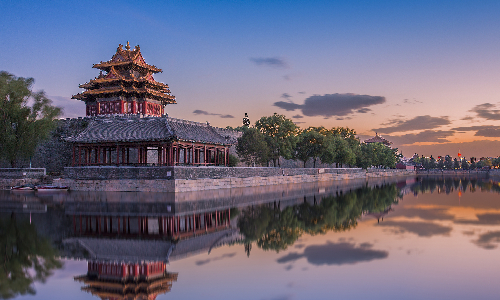

Today we will visit the Ming Tombs. It is located about 50 kilometers northwest of Beijing, and it takes about 1.5 hours to get there. The Ming Tombs were built between 1409 and 1645, covering an area of 40 square kilometers. And it is the largest existing imperial tomb group in the world with the largest number of imperial tombs. When visiting this place, we will walk on the Sacred Way. It is a road built in the year of 1540 (Ming Dynasty, 1368-1644). Except for the damaged bridges and culverts, other tomb facilities are well preserved. As you walk on this road, you will encounter 12 pairs of stone beasts and 6 pairs of stone people, which are the special carvings for ancient royal tombs. When you admire these lifelike and majestic stone carvings, you may also feel the majesty of the owners of the tombs.
After this, we will go to Ding Tomb. The tomb is the only tomb being excavated of all Ming Dynasty Tombs. In 1957, the Chinese archaeological team excavated the Ding Tomb (the tomb of the 13th emperor of the Ming Dynasty) in the Ming Tombs, which brought great misfortune for Chinese archaeology. When the archaeologists opened the gate of the tomb, a lot of air rushed into it, and the cultural relics that had been sealed for hundreds of years were oxidized rapidly. A large number of colored cultural relics faded and all kinds of silk as well as satin decayed in a short time, which was a huge loss of precious cultural relics. After that, Chinese government issued the regulation that it is forbidden to excavate tombs anymore. Fortunately, there are still some cultural relics unearthed in Ding tomb. You can come and visit these precious cultural relics.
After lunch, we will head to the Juyongguan Great Wall. The Juyongguan Great Wall is located 25 kilometers northwest of the Ming Tombs, and it takes about 30 minutes by car to get there. As one of the most famous attractions in China, the Great Wall was once a defensive project built to resist aggression. The Juyongguan Great Wall was built in a 15-kilometer-long valley, with spectacular mountains and lush trees on both sides. In addition, it was a place especially favored by ancient Chinese poets, who had written a large number of poems and inscriptions depicting Juyongguan. Among these works, there are about 170 ancient poems, nearly 13,000 words. I believe that when you stand on the Great Wall and look at the endless mountains and the Great Wall in the distance, you will be shocked by this world-famous project. Then, our tour guide will escort you to the hotel after the Great Wall tour.


 Xi’an
Xi’an Today we will leave Beijing and head to Xi’an. You will take the estimated train G655 09:43/15:22 to Xi’an, where a guide will pick you up and escort you to the hotel. Please have a good rest in the hotel and save your energy for the next Xi’an journey!
Today we will first visit the Terra Cotta Warriors and Horses Museum. The museum is located 43 kilometers east of Xi’an, and it takes about 40 minutes by car to get there. It is built on the original site of the Terra Cotta Warriors and Horses. This museum is the largest ancient military museum in China. The Terra Cotta Warriors and Horses is regarded as one of the Eight Wonders of the World. As the burial objects of the first emperor of China, Qin Shihuang, these terra cotta warriors and horses reflect the majesty of Emperor Qin Shihuang as well as the flourishing and invigorating of Qin Dynasty(221BC-207BC). The most amazing thing about these terra cotta warriors is their looks. When you observe them, you will find that each terra cotta warrior in front of you is different and as if each one is a real person. These terra cotta warriors and horses are all in the burial pits. There are three burial pits in total. The three burial pits cover an area of more than 20,000 square meters, and there are nearly 8,000 terra cotta warriors and horses, which are similar in size to real people and real horses. There are also different types of troops, such as chariots, cavalry, and infantry, arranged in an orderly manner. When you admire these terra cotta warriors and horses, I believe you will be impressed by the outstanding skills of Chinese craftsmen more than 2,000 years ago.
After visiting the Terra Cotta Warriors and Horses Museum, we will go to another museum, Xi’an Beilin Museum, which is the earliest museum in Shaanxi (the province where Xi’an is located). This museum is built on the site of Xi’an Stele Forest. It mainly collects, displays, and studies the steles and stone sculptures of past dynasties, which makes it a unique art museum in China. There are more than 11,000 cultural relics in the museum. In the museum, the most precious cultural relics are the Zhaoling Six Horses, which are carved in stone. It is said the six carved stone horses are made with six horses that accompany Tang Taizong (one of the greatest emperors of the Tang Dynasty, 618-907) to the battlefield as the prototypes. Among the six carved stone horses, two of them are stolen and sold to foreign country(Now the two are preserved in a foreign museum.). Later, Chinese experts copied the stolen two stone horses according to existing pictures and rubbings. Now, six carved stone horses are kept in Xi’an Beilin Museum. The horses are carved to commemorate the six horses in the battlefield. Each horse is carved out of a complete bluestone, which is about 204 centimeter wide, 172 centimeter high, and 40 centimeter thick. In addition, bas-relief technique is used for the six carved horses, who are carved with simple carving lines and accurate modeling, vividly showing the posture and character of the six horses as well as the scene that as if they are galloping on the battlefield. When you stand in front of these stone carvings, perhaps you can also imagine the scene that the six horses followed Tang Taizong to defeat the enemies more than a thousand years ago.
After visiting the Xi’an Beilin Museum, we will head to Xi’an Ancient City Wall. It is the largest and best-preserved city wall in China. The wall was built for defense in ancient China. The thickness of the city wall exceeds its height, making it as stable as a mountain. The wall is 12 meters high; the top width is 12-14 meters; the bottom width is 15-18 meters; and the circumference is 13.74 kilometers. In ancient times, soldiers were often trained on the top of the wall. Although there are 18 gates for the Xi’an Ancient City Wall, only four gates are the main gates, which are designed in four directions(east, west, south, north). Each main gate is designed with three defensive buildings: gate tower, arrow tower, and main tower. The gate tower is the outermost building, and its function is to lift the suspension bridge over the city moat; the arrow tower is in the middle, and there are square windows on its front and both sides for shooting enemy; the main tower is the innermost building, under which is one main gate. You can walk on the city wall, admiring these defensive buildings hundreds of years ago and imagining the scenes of soldiers killing enemies. After visiting the city wall, the guide will escort you back to the hotel.


 Chengdu
Chengdu Today we will leave Xi’an and head to Chengdu. You will take the estimated train G89 11:28/14:38 to Chengdu, where our tour guide will pick you up and escort you to the hotel.
Today we will go to Chengdu Research Base of Giant Panda Breeding, where you can see the cute giant pandas! Giant pandas have lived on the earth for at least 8 million years and are known as “living fossils” and “Chinese national treasures.” Excluding half of the time for eating every day, the pandas spend most of the remaining time in sleep. The wild giant pandas sleep for 2-4 hours between meals. 99% of giant pandas’ food is bamboo. And more than 60 kinds of bamboos can be eaten by giant pandas. Giant pandas in the wild have a life span of 18-20 years. And they were once on the verge of extinction. Luckily, the pandas in this base get good protection and are well taken care of. Comfortable living condition and playing environment are created for them. Furthermore, in addition to eating fresh bamboos, they will also be fed with nutritious foods. You can enjoy watching these lovely national treasures in this base!
After lunch, we will go to Du Fu Thatched Cottage. Du Fu is one of the greatest poets in China. Besides, he has also been admired by countless people for thousands of years because he is sympathetic to the people’s livelihood. The cottage was his former residence when he lived in Chengdu. He lived here for nearly four years and composed more than 240 poems. When you enter the main entrance of the cottage, you will see a plaque written by Yunli, the 17th Prince of Emperor Kangxi (the fourth emperor of the Qing Dynasty, 1636-1912). The Poetry History Hall is the central building of the cottage. In the center of the hall is a statue of Du Fu made by a famous sculptor. Besides, couplets and plaques inscribed by celebrities of the past dynasties are displayed in the hall. Maybe you cannot understand the meanings of these couplets and plagues, you can admire these exquisite Chinese arts.
After lunch, we will go to Chengdu Wuhou Shrine Museum. If you know something about the Romance of the Three Kingdoms, one of the four classic novels of Chinese literature, you must have heard of Zhuge Liang. For thousands of years, various heroes of the Three Kingdoms period (220-280) of China have been widely known among the Chinese people, and among them, the most famous and respected is Zhuge Liang. He is also known as Wuhou. An ancestral hall is built to commemorate him. There is a very famous story about Zhuge Liang, and you may also feel his wisdom from this story. In a war between the Kingdom of Wu and the Kingdom of Shu against the Kingdom of Wei, Zhou Yu (military adviser of Wu) wanted to make Zhuge Liang (military adviser of Shu) embarrassed to prove he is smarter. Zhou commanded Zhuge Liang to produce 100,000 arrows in ten days. This was an impossible task, but Zhuge Liang did it in three days. In the first two days, he ordered people to prepare twenty large boats with thatch covered on the deck and the top of the boats. On the third day(a misty day), Zhuge Liang ordered setting sail to Wei’s territory, beating the drums and pretending to attack. The leader of Wei was really scared, but he couldn’t judge the situation because of the heavy fog. So he only ordered the archers to shoot arrows at Zhuge Liang’s boats from a distance. As a result, almost all these arrows were shot into the thatch on the boats. And this clever trick enabled Zhuge Liang to get countless arrows and fulfill the task that Zhou Yu gave him.
After visiting Chengdu Wuhou Shrine Museum, we will head to Jinli Street. The street is adjacent to Chengdu Wuhou Shrine Museum and it is a famous pedestrian street in Chengdu. The buildings here are built with the architectural style of the late Qing Dynasty. In this area, you may see authentic folk arts, such as shadow puppetry, paper-cut art and sugar-figure blowing art. Besides, you can also see a variety of Chengdu snacks, which are China-famous. After the tour, the guide will send you back to the hotel.

Today we will go to visit Leshan Giant Buddha. The Buddha is 71 meters high and is the largest carved stone statue in China. Its carving starts in 713 and ends in 803, which lasts about 90 years. I believe that when you come here, you will be shocked by the majestic scene in front of you. The head of the Leshan Giant Buddha is in line with the top of the mountains, with its feet stepping on the river. The body of it is well-proportioned. The statue is 71 meters high, with its head height of 14.7 meters and head width of 10 meters. Only when you really stand in front of this Buddha, will you realize how big it is. Besides, a set of drainage system is designed for this giant Buddha statue. A ditch is built on the surface of the Buddha’s body, and there are hidden drainage outlets behind its ears and head. It is this set of drainage system that protect the Buddha statue from the corrosion of rain.
After lunch, we will head to Huanglongxi Ancient Town. This town has a history of more than 1,700 years. Currently there are 76 houses of the style of Ming and Qing dynasties. In addition to its long history, the longevity noodles is the most famous food in this town. This food will be served with only one very long noodle in one bowl. Local people believe that eating the longevity noodles means living a long life. In addition, the most enjoyable thing when you come to the town is to take a small boat to enjoy the scenery on both sides of the Huanglongxi Stream. I believe this will be an unforgettable afternoon for you! After the tour, the guide will send you back to the hotel.
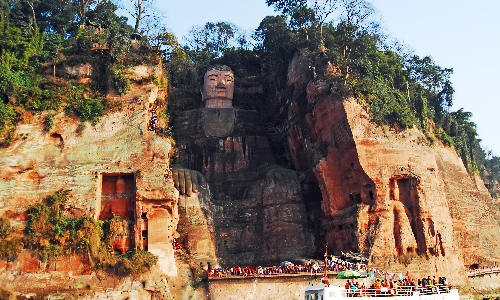
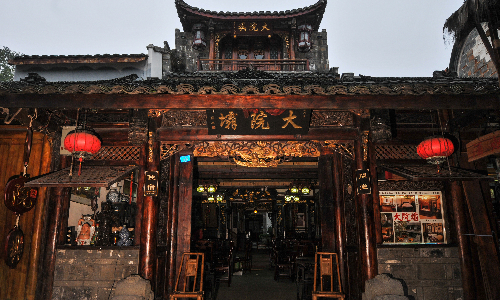
 Shanghai
Shanghai Today you will take the estimated flight CA1948 12:00/15:00 to leave Chengdu and head to Shanghai. Our local guide will wait for you at the airport and then escort you to the hotel.
As one of the most developed cities in China, Shanghai is famous for its status as a financial center. But, in fact, Shanghai is also a city with a long history. The first stop we will visit today is an ancient temple, Jing’an Temple. The history of the temple can be traced back to 247. From south to north, the temple is designed with Bell Tower, Drum Tower, Main Shrine Hall, and Dharma Hall. And the most magnificent one is the Main Shrine Hall. After entering the hall, you will see a statue of Sakyamuni Buddha, which is cast with about 15 tons of silver. Pray for some good things in front of this sacred Buddha statue.
After visiting Jing’an Temple, we will head to Yu Garden (closed each Monday). Yu Garden was originally a private garden in the Ming Dynasty with a history of more than 400 years. In the Yu Garden, there are various pavilions, halls, rockeries, plants, etc. One eye-catching attraction is the ginkgo tree, which has a history of over 400 years. It is 21 meters high with dense branches. In addition, around the Yulexie Pavilion, towering ancient trees can also be seen. There is a wisteria tree with a history of over 300 years next to the Yulexie Pavilion. I believe that after visiting Yu Garden, you will have a deeper understanding of Chinese gardens in south China.
After lunch, we will head to Shanghai Tower. The Shanghai Tower is a huge high-rise landmark skyscraper in Shanghai. The tower has a total construction area of 578,000 square meters, with 127 floors above ground and 5 floors underground. It has a total height of 632 meters. Viewed from the top, the shape of the Shanghai Tower is like a guitar pick. As the height increases, each floor is twisted by nearly 1 degree. Such a design can reduce air resistance effectively. When visiting this tallest building in Shanghai, we will go up to the 118th floor, where there is a 360-degree sightseeing hall and you can overlook Shanghai from here!
After visiting the Shanghai Tower, we will head to the Bund. The Bund is located on the west bank of Huangpu River and is a Chinese cultural district. When you come to the Bund, you will see beautiful scenery of Huangpu River, and spectacular buildings of various styles. These buildings are of various architectural styles such as Gothic, Baroque, and East Indian style. Among them, the China Commercial Bank Building at No.6 on the Bund is very eye-catching. It is one of the oldest buildings on the Bund. The exterior wall of the building is veneered by granite, with a row of sharp corners in Gothic style. It is a typical building on the Bund at the end of the 19th century. You may even find buildings similar to the architectural style of your hometown here!
After visiting the Bund, we will directly go to Nanjing Road. The various food and stores there will definitely help you to reduce your fatigue! Nanjing Road, with a total length of 5.5 kilometers, is the first commercial street established in Shanghai after the opening of its ports. The time-honored delicacies on the street attract lots of visitors everyday, such as biscuits, Cantonese cuisine, dim sum, sliced duck, smoked fish, and pork moon cakes. If you also want to bring some Shanghai specialties to your family members and friends, coming Nanjing Road is the best choice! After the tour, the guide will escort you back to the hotel.
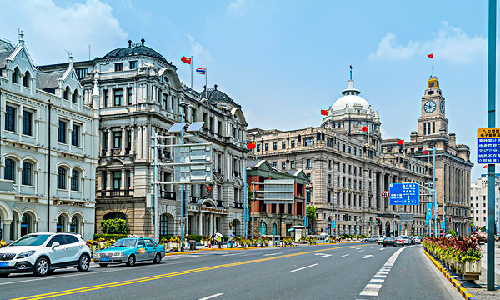
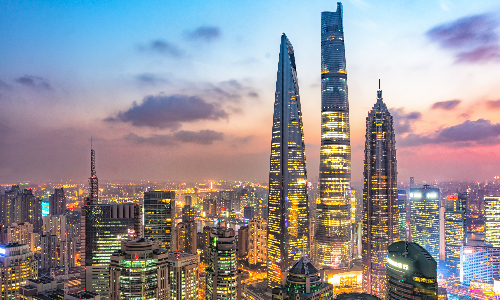
Today our 11-day tour to China is over! Our guide will escort you to the airport. Hope you enjoy this trip!
Author: Ziyang Zhang
Proofreader: Yan Liu
| City | Five Star hotel list | Four Star hotel list |
|---|---|---|
| Beijing | Sunworld Dynasty Hotel Beijing Wangfujing | Sunworld Hotel Wangfujing |
| Xi'an | Tianyu Gloria Grand Hotel Xi'an | Sunworld Dynasty Hotel |
| Chengdu | Sofitel Chengdu Taihe | Holiday Inn Express Chengdu Jinniu |
| Shanghai | Ocean Hotel Shanghai | Ambassador Hotel |
 |
![]() About your child or infant, please contact us for a discounted price.
About your child or infant, please contact us for a discounted price.



We started with a few days in Beijing & ended in Shanghai, from where we visited the Forbidden City and Great Wall. In between we visited Terra Cotta Warriors Museum, Panda Base, Shanghai Disneyland.

We had a wonderful holiday in China which will remain long in the memory. China is a breathtakingly beautiful country full of splendid temples and palaces, mountains and rivers, peaceful rural scenes and bustling shopping streets.
 QUICK ENQUIRY
QUICK ENQUIRY